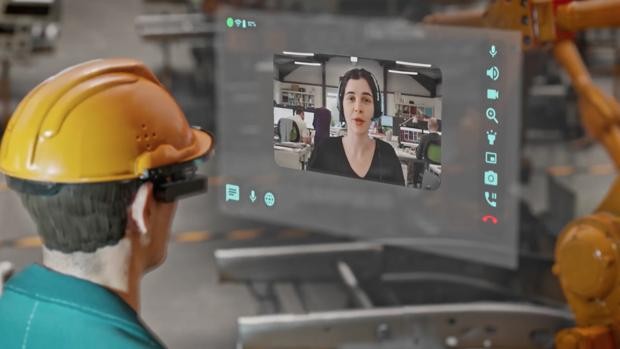On-site technology to reduce workplace accidents
13.06.2022
The accident rate is a problem that affects all sectors, but is particularly virulent in the construction industry. According to the latest data available from the Ministry of Employment, the incidence rate in 2020, a year marked by the impact of Covid, was 2,455.1 accidents with sick leave per 100,000 workers. And the sector of activity with the highest incidence rate was construction, with 5,804.1, which more than doubled the average of the sectoral rates. As Fernando Sanz, head of the Industrial Safety department of the National Centre for New Technologies highlighted in a recent webinar, “there were 118 fatal accidents in construction during 2021, and between 2017 and 2019, the construction sector recorded 286 deaths on site, 63% due to falls from heights”.
Reducing this impact is a priority for companies in the sector. And to achieve this complex objective, innovation and technology have become natural and decisive allies. As the Construction Labour Foundation points out, “the characteristics, nature and particular conditions of the sector make it particularly complex for the achievement of all the aspects to be taken into account in terms of occupational risk prevention (ORP)”. A complexity that is accentuated, beyond the real estate sector, in the field of large infrastructures.
From the point of view of prevention, Cristina Calderón, director of the Prevention, Quality and Environment department of the construction company Arpada, highlights recent initiatives in her company, such as the synergy between the BIM (Building Information Modeling) department and the Prevention department: “We started working together to analyse the feasibility of using a Common Data Environment (ECD-CDE) and the usefulness of 3D project management, to manage occupational risk prevention with different digital tools, thus improving communication, traceability of incidents and encouraging collaborative work.” This planning allows for closer contact between architects, project managers, Health and Safety coordinators, manufacturers…
Since 2016, the Arpada Chair has been teaching at the Etsem (Escuela Técnica Superior de Edificación) of the Polytechnic University of Madrid. Antonio Ros, a technical architect with a PhD from the UPM, is a lecturer and coordinator of the Prevention and Safety II discipline in the Degree and Double Degree in Building and ADE, and begins his statements by highlighting how the Law on Occupational Risk Prevention includes as one of the principles of preventive action “taking into account the evolution of technology”. And he points out that “the evolution of new technologies, the advance of communications and the innovation and research projects carried out by the building sector, both companies and public entities and the university itself, achieve an improvement in health and safety in this sector… which maintains high accident rates”.
The appearance of applications and platforms related to documentation and management in building works (with cases such as electronic books, portals for documentation, etc.) have improved the level of prevention, an environment in which Ros highlights hopeful contributions “such as, for example, the Internet of Things technology that interconnects devices and objects through a network to speed up data transfer, supported by NB (NarrowBand) communication, which is faster and more energy efficient”.
In the case of Sacyr, they have projects such as SIMULADrón, a training system for piloting drones in a virtual and controlled environment. “Through this training system (the company points out), we are able to improve skills in complex operations such as checking neoprenes on bridge piers or checking the state of slopes, allowing these tasks to be carried out in a real environment, with practically no impact on the road and without putting workers at risk”.
As for the Soter Project, the use of IOT is used to monitor workers: thanks to geolocation, it is possible to know if, for example, they have suffered a fall or heat stroke. And there are already sensors that can analyse brainwaves for signs of fatigue, a potential precursor to accidents. From there, advances in ‘big data’ and artificial intelligence provide an arsenal of information to help decisively in prevention, which is integrated into the company’s programmes such as its own open innovation programme, Sacyr iChallenges.
Simulate, prevent
Virtual and augmented reality also join this battery of actions, as well as initiatives such as those highlighted by the Construction Labour Foundation: “Dynamic tools for training (‘gamification’/’serious games’), in a ‘Construction 4.0’ environment, introduce a decisive advance. And we highlight the BIM methodology, which allows the integral management of projects, by means of virtual models and ‘intelligent’ traceability of data”. The institution has launched, in collaboration with Cype Ingenieros, the free application ‘PRL in BIM’.
The foundation also points out the importance of its VRoad project, part of the Erasmus+ programme, which has created a virtual reality application for learning about health and safety work in road maintenance and operation (guardrail repair, action in the event of a spill on the road, etc.). And in this same framework, the SetAr project seeks to reduce the accident rate during excavation work with a training methodology based on the use of augmented reality.
Another vision of safety
European projects encourage the use of solutions such as Augmented Reality to reduce the possibilities of risk: this is the case of cases in which the Fundación Laboral de la Construcción participates, such as ARCW (safety and health for the construction of curtain walls) and Arfat (training in the safe assembly and dismantling of formwork and scaffolding). In both projects, AR applications were designed to drive training through innovative learning methods and the use of platforms and applications for mobile devices, as is being done in SetAr. Bionic (‘smart’ clothing) or Upp Games (for work at heights in the construction sector).
By ABC Diario.

